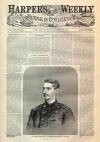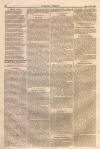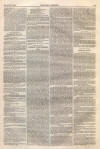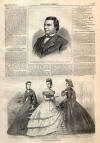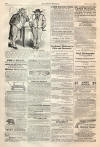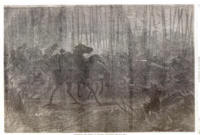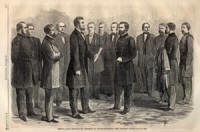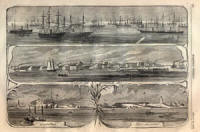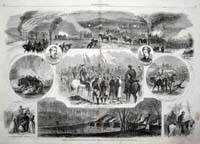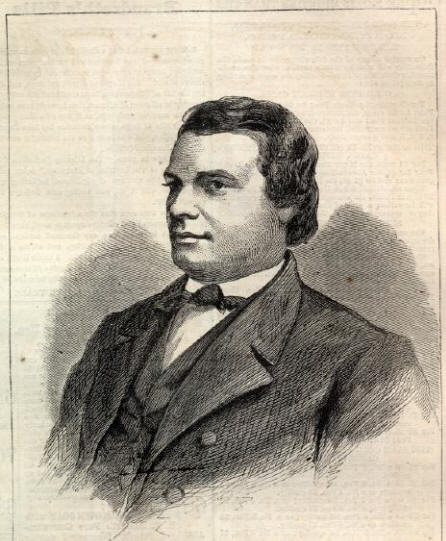|
This Site:
Civil War
Civil War Overview
Civil War 1861
Civil War 1862
Civil War 1863
Civil War 1864
Civil War 1865
Civil War Battles
Confederate Generals
Union Generals
Confederate History
Robert E. Lee
Civil War Medicine
Lincoln Assassination
Slavery
Site Search
Civil War Links
Civil War Art
Mexican War
Republic of Texas
Indians
Winslow Homer
Thomas Nast
Mathew Brady
Western Art
Civil War Gifts
Robert E. Lee Portrait
|
HON. MICHAEL HAHN, GOVERNOR OF LOUISIANA.—[PHOTO.
BY. LILIENTHAL,
NEW ORLEANS.]
MOBILE AND ITS DEFENSES.
WE give on
page 204 an
illustration showing the position of the Federal fleet off the harbor of Mobile,
together with the defenses of the harbor. At last accounts (25th ult.)
Admiral
FARRAGUT was bombarding Fort Powell, which commands Grant's Pass, on the left
of the picture. This fort is bomb-proof, but, under the vigorous fire directed
against it, could not, it was believed at the date of the latest advices, long
hold out. The reduction of this fort is necessary to enable FARRAGUT to send his
mosquito fleet through the Pass into the harbor of Mobile, by which he will cut
off forts Gaines and Morgan. The distance from Fort Powell is thirty miles, nine
of which are through a narrow channel, with its banks fortified the entire
distance. Fort Morgan is a very strong work, protected on the sea front by a
strong water-battery of masonry and turf. The fort and battery, with their full
battery, mount forty-five guns, mostly Columbiads of heavy calibre. Fort Gaines
is situated on Dauphin's Island Point, three miles and one fourth from and
nearly opposite Fort Morgan, and is heavily mounted. Vessels drawing more than
seven and a half feet are compelled to pass between these forts; and
obstructions placed in the channel will make the passage for FARRAGUT still more
difficult.
Mobile is one of the largest
cities on the Gulf, and is fairly environed by defenses thrown up during the
last two years. The authorities, however, do not appear to feel secure against
assault ; for on the 25th ult. the Mayor of the city issued a proclamation
requesting all non-combatants to leave the city, intimating that its capture was
not impossible, and that in any case, if the city should be besieged, suffering
might result from the want of supplies.
HONORABLE MICHAEL HAHN,
GOVERNOR OF LOUISIANA.
THE 4th of March was the
beginning of a new era in the history of Louisiana. Not only was the Federal
authority on that day formally re-established, but a State Administration fully
in accord with the liberal spirit of the times was installed amidst the
rejoicings of thousands of citizens. The inauguration of MICHAEL HASHN, the
Governor elect, whose portrait we here give, was attended by a grand and
imposing display—all the school-children of the city, all the veteran and
volunteer soldiers, all the Federal and city officials participating in the
demonstration. The inauguration ceremonies took place in Lafayette Square, which
was densely crowded with people. Mr. HAHN, when formally installed, delivered
his Inaugural Address, pledging himself to an unconditionally loyal policy, and
taking high ground in favor of the extinction of Slavery, which he denominated
the cause of all our present troubles.
Governor HAHN was born in
Bavaria, Germany, in the year 1830, and is consequently in the thirty-fourth
year of his age. He came to this country when a mere child, his mother settling
in New York city. When ten years of age, he went with his mo-
ther and sisters to Texas,
whence, some time after, they removed to New Orleans, where Mr. Hahn has ever
since resided. In 1840 his mother died of yellow fever. At the age of 18 he
commenced the study of the law, and at 20 graduated with honor at the Louisiana
University, at once taking a prominent position in the community.
In politics Mr. HAHN was always a
Democrat, and in the last Presidential campaign was a member of the
DOUGLAS
Executive Committee. When secession was first proposed in the spring of 1861, he
took strong ground against it, and during all
the time the rebels ruled in New
Orleans refused to fall in with the prevailing madness. Upon the occupation of
New Orleans by our forces he was among the first to step forward to the help of
General BUTLER. In December, 1862, Mr. HAHN was elected to Congress, where he
some became recognized as a man of undoubted patriotism and ability. He was
elected Governor in February last by a majority of 996 over both competitors, in
a total vote of 11,346, every loyal paper in the State supporting his claims for
the exalted and responsible position.
BY
THE RIVER.
The sunshine quivered on the
quivering poplars That grow beside the stream;
And o'er the distant hills there
seemed a glory, A gold and purple gleam ;
And I know That even in the March
wind there was music, And in the river's flow.
I loved to hear the sighing of
the water,
To mark its green depths shine;
But more I loved two brown eyes,
calm and tender, A dear hand clasped in mine;
For I know If thought that love
would last forever, changeless, Though rivers ceased to flow.
Gone is the sunshine from the
quivering poplars, The glory from the land;
Gone, the brown eyes that made
the sunshine brighter, And gone the clasping hand;
But I know My tears are like the
river—ah, the river! That can not cease to flow.
PARIS FASHIONS FOR MARCH.
THE Fashions for March are very
much modified by the Siberian state of the temperature during the latter part of
February. An exaggeration has been developed in the head-dress, which has become
an amphitheatre composed of flowers, feathers, ribbons, velvet, and precious
stones. On account of the space taken up in this manner, polite husbands mount
the box by the side of the coachman. The more permanent bonnet, however, it is
officially announced, is to lose in the coming Spring all that the head-dress
has gained. The chapeaux are no longer to be high floral expositions, but almost
flat over the forehead, close fitting to the outline of the face, and small in
proportion every way; thus returning to the style so long adopted in England,
which often indicated in Paris the nationality of the pretty British tourist
contrasted with the Parisian belles, who now affect the black silk or velvet
bonnet, ornamented with jet, per preference. Other colors, mostly in velvet, are
admissible, but neutral shades are the most distingues.
THE ILLUSTRATIONS.
Fig. 1. Evening Dress.—Lilac end
taffety robe, with open corsage. The lapels are in red, blue, and green plaid
velvet, buttoning over the waist by a double row of buttons. The waistband and
cuffs are likewise in velvet plaid; but from the former depends a long and wide
silk tartan streamer. The chemisette is embroidered and provided with a small
upright collar, fastened with a narrow light blue cravat. Fig. 2. Ball
Dress.—White tulle robe, trimmed with six flounces of hollow plaits. Over the
robe are placed three jupes of plain tulle, forming a tunic, and drawn up at the
side by it bouquet of flowers to which they are attached. Pointed corsage,
provided with drapery, fastened at the shoulders and in the centre with small
roses. The coiffure is of the latest mode, the hair being raised in front and
ornamented with an abundance of flowers. Fig.. 3. Carriage Dress.—Light green
velvet robe of the style known as the style Prineesse, trimmed above the seem,
round the pockets, and on the sleeves with rolls of fur. The front of the skirt
and of the corsage is closed with black velvet buttons. Brown velvet bonnet of
the modified form, decorated with a feather fastened to the top of the crown by
a large rose, similar to that ornamenting the front of the chapeau.
PARIS FASHIONS FOR MARCH, 1864.
|
